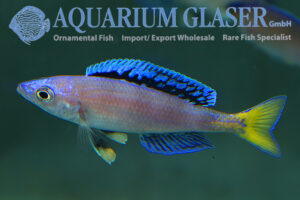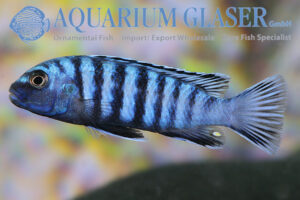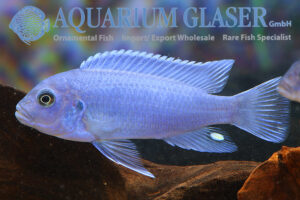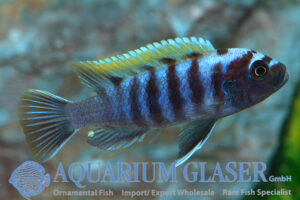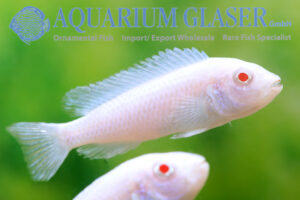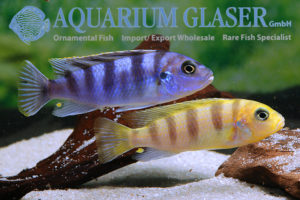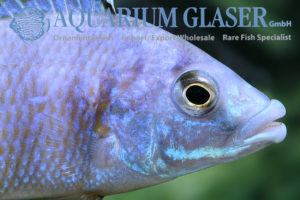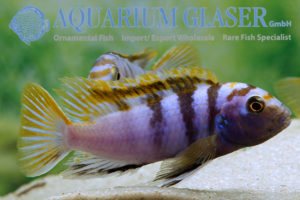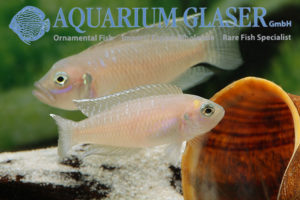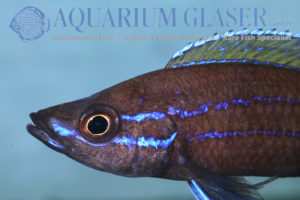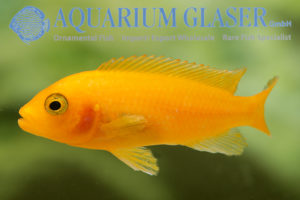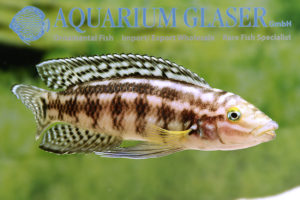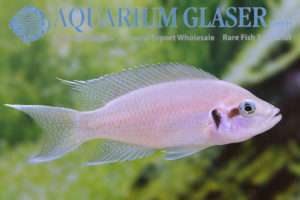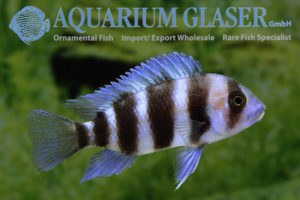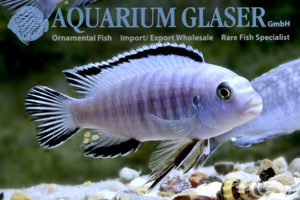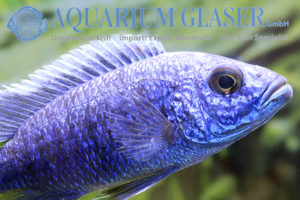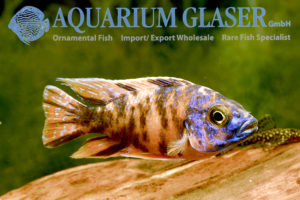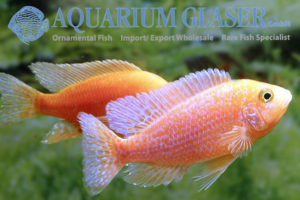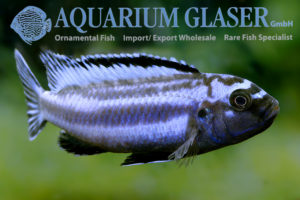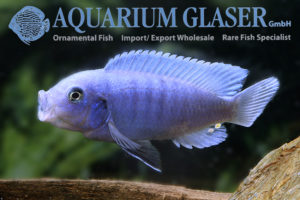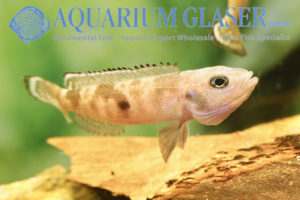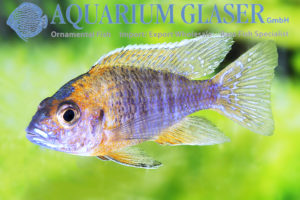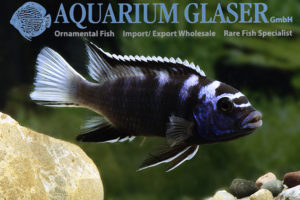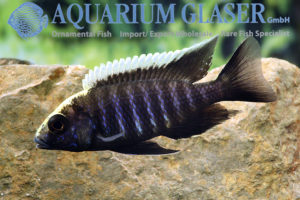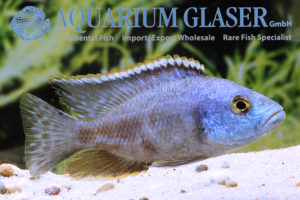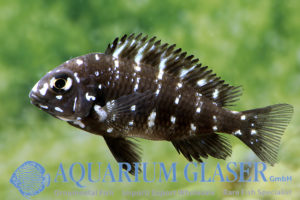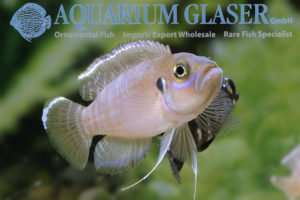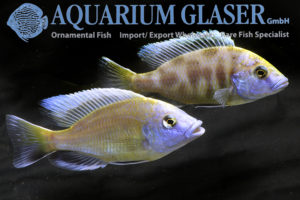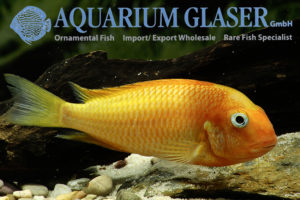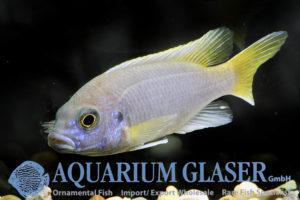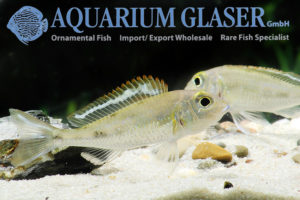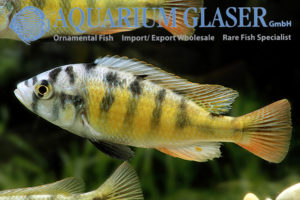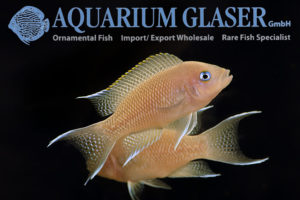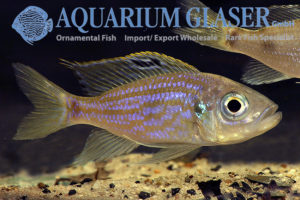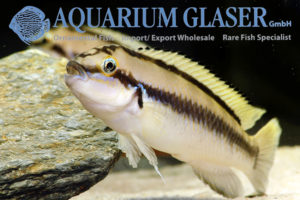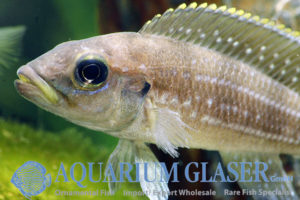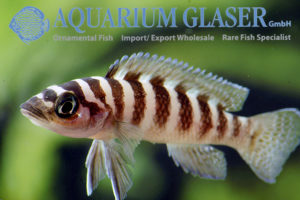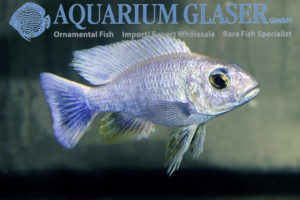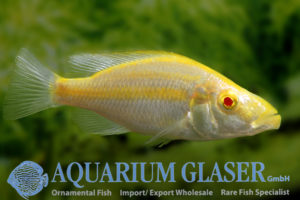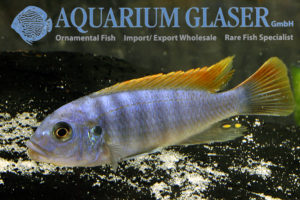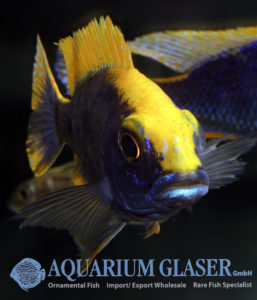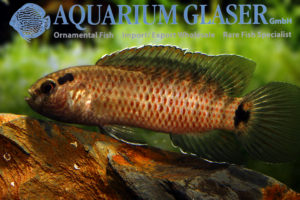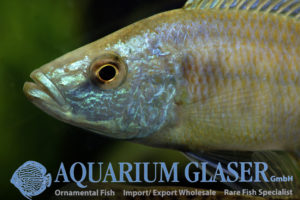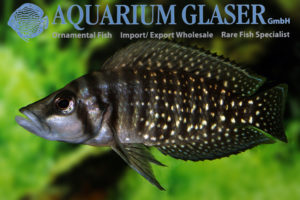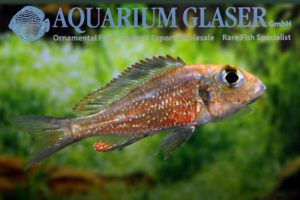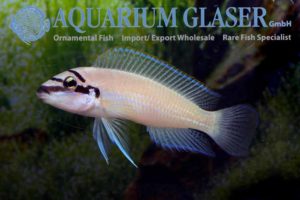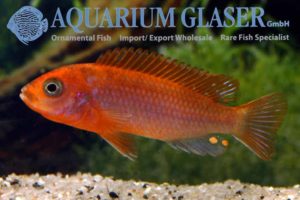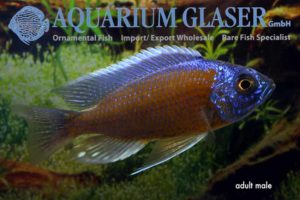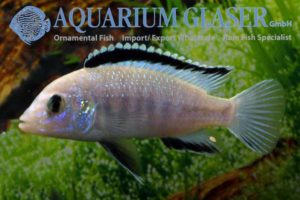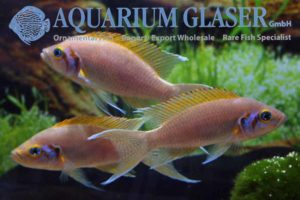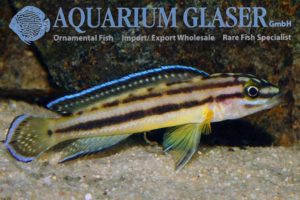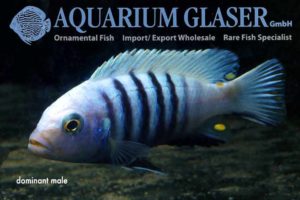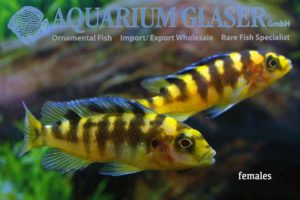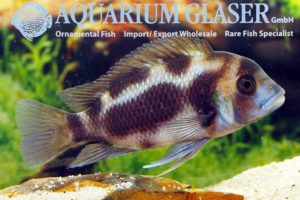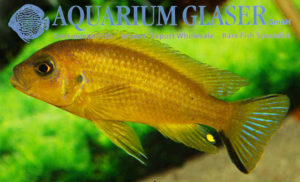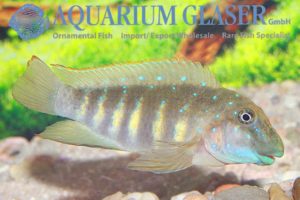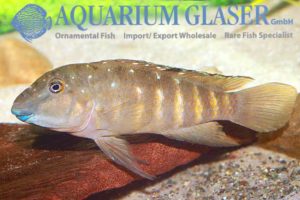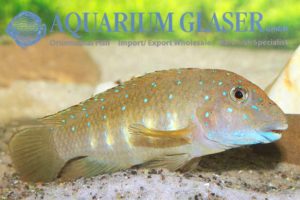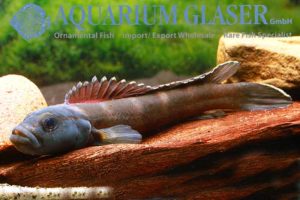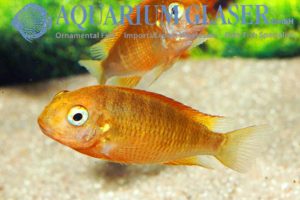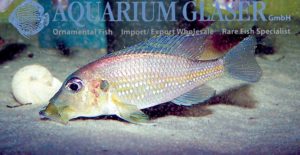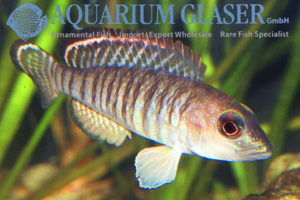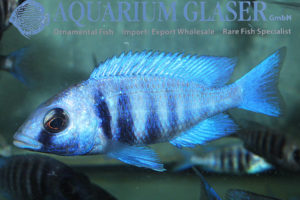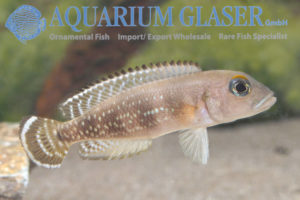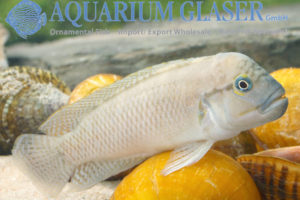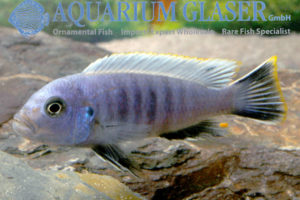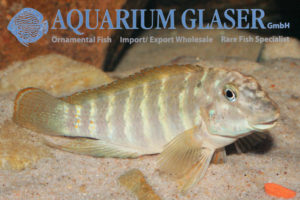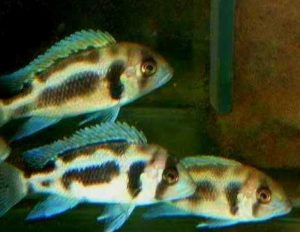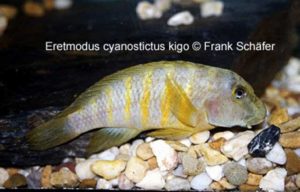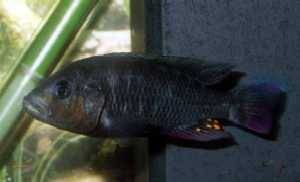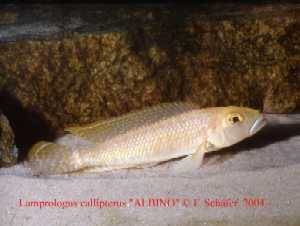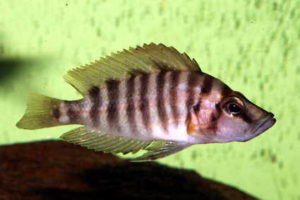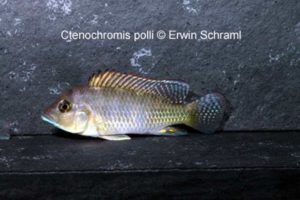Cyprichromis and Paracyprichromis are very special mouthbrooding cichlids from Lake Tanganyika. The animals sometimes live in huge shoals and feed on small animals that they pick out of the free water column. To attract the attention of the females, the males can be very brightly colored. They do not occupy actual territories. The females, on […]
25b. Perchlike fishes (2): Cichlids from the Great African Lakes (74)
-
-
Chindongo elongatus (formerly Pseudotropheus elongatus)
The former large genus Pseudotropheus is currently divided into four genera: Pseudotropheus, Maylandia, Tropheops and Chindongo. The type species of the genus Chindongo, C. bellicosus, which was described together with the genus in 2016, is one of the most combative mbuna of all. The species name “bellicosus” means “belligerent”! Chindongo includes the species C. ater, […]
-
Maylandia callainos Blue/Blue
The zebra cichlids of Lake Malawi (genus Maylandia, synonym: Metriaclima) are still very popular due to their bright colors. In nature, many species are polychromatic. This means “multi-colored” and means that highly differently colored individuals can occur within a population. In M. callainos, the males are cobalt blue (“cobalt zebra”) and develop an intense, brilliant […]
-
Maylandia emmiltos
The very first Lake Malawi cichlids came from the group of rock-dwelling cichlids, called Mbuna after a local name, in the late 1950s and early 1960s, including a fish identified as Pseudotropheus zebra in 1964. Today we know dozens of species from this zebra complex, which are often only distributed very locally, but sometimes also […]
-
Chindongo socolofi “Albino” ( = Pseudotropheus socolofi)
The question of whether an ornamental fish species is particularly popular can often be answered with “yes” if breeding forms exist. Breeding forms, whose characteristics either do not occur at all in nature or only occur extremely rarely in individual specimens, usually only arise when the natural form is bred on a large scale. The […]
-
Maylandia lombardoi
Who remembers art class in school? Among the first things you learn are color temperatures, right? According to this, red, yellow and orange are warm colors, while blue, green and purple are cool colors. In Lake Malawi’s rock cichlids, the mbuna, the territory-owning males usually shine in cool colors (usually blue), and the females exhibit […]
-
Placidochromis milomo
Lake Malawi in the heart of Africa is home to an enormous variety of cichlids. Often it is difficult to decide whether in individual cases they are different species or local variants. Extremely popular in aquaristics are the rock cichlids (Mbuna). But also among the non-Mbuna, which in their habitat are not so dependent on […]
-
Labidochromis sp. “Mbamba”
At first sight one could think Labidochromis sp. “Mbamba” (the species is not yet scientifically described) is a typical mbuna of Lake Malawi: blue ground color, zebra stripes. But in reality Labidochromis sp. “Mbamba” is quite different. It is not a mbuna in the real sense, which are known to be algae/Aufwuchs eaters and aggressively […]
-
Lamprologus brevis
Snail cichlids are fascinating animals. They have chosen empty snail shells – in Lake Tanganyika there are large accumulations of empty shells of snails of the genus Neothauma – as their center of life. Neothauma snails are with a diameter of 4-5 cm relatively large snails from the relationship of the mystery snails. However, in […]
-
Paracyprichromis nigripinnis “Blue Neon”
Cyprichromis and Paracyprichromis are very special mouthbrooding cichlids from Lake Tanganyika. They live in sometimes huge schools and feed on small animals that they pick from the free water column. To attract the attention of females, the males can be very colorful. They do not occupy actual territories. The females, on the other hand, are […]
-
Maylandia estherae Red/Red
One of the most popular, because most colorful cichlids of Lake Malawi is the O-form of Maylandia estherae (synonym: Metriaclima e.). “O” stands for “orange.” As with many other species of Lake Malawi, several color forms occur within the same population of M. estherae in the wild. In the “normal” color form of M. estherae, […]
-
Julidochromis marlieri
The julies (Julidochromis) belong to the most popular cichlids from Lake Tanganyika. They are very beautiful, colorful and comparatively peaceful animals. Of course, for reproduction territories are formed and defended against other fish. All Julidochromis are recommendable aquarium fish, there is a suitable species for every aquarium. The largest is J. marlieri, of which we […]
-
Neolamprologus pulcher (= N. brichardi)
Whoever coined the name “Princess of Burundi” for this beautiful small cichlid: it is a brilliant name! The fish commonly known as Neolamprologus brichardi is by no means found only in Burundi, but is distributed in numerous color variants in Lake Tanganyika, which led to several scientific descriptions: Lamprologus savoryi pulcher, L. olivaceus, L. elongatus […]
-
Cyphotilapia frontosa
The humpheaded Frontosa (Cyphotilapia frontosa) from Lake Tanganyika has enjoyed great popularity for decades, although (or: because!) the species belongs to the bull class among the cichlids. Old males, which look downright bizarre with their forehead hump, can grow 30 cm long. Females generally remain smaller. In addition, C. frontosa is a crepuscular predator that […]
-
Chindongo socolofi (= Pseudotropheus s.)
What is the saying? Who does not ask, remains stupid. In the case of the rock cichlids of Lake Malawi, the so-called Mbuna, it is undoubtedly the garish, bright colors that initially attract attention and led to the much quoted comparison with coral fish. In fact, the colors of the mbuna have primarily the same […]
-
Sciaenochromis fryeri
Many rock dwelling cichlids (mbunas) of Lake Malawi live isolated on certain rocky shores. These are often miles away from other rocky biotopes, so geographic isolation leads relatively quickly to local color variations. Other cichlids of the lake, such as Sciaenchromis fryeri, are not bound to specific biotopes and occur accordingly throughout the lake. Although […]
-
Aulonocara Orange Blotched
Everything there is to say about these wonderfully colorful cichlids has already been said about another breeding variety, the Aulonocara Dragon Blood: https://www.aquariumglaser.de/en/fish-archives/aulonocara-dragon-blood-2/ The Orange Blotched are now one of the most common Malawi cichlids on the market. No wonder: there is hardly a fish species, which shows such a variety of bright colors, like […]
-
Aulonocara “Dragon Blood”
Aulonocara are a specious and colorful genus of Malawi cichlids; because of their brightly colored dress they are called “peacocks” in English. They are small-animal eaters that selectively ingest small chunks of food. Another group of cichlids in Lake Malawi feeds on the algae and the microorganisms (= Aufwuchs) they contain, which grow on rocks. […]
-
Melanochromis johannii
The bluegray mbuna or the electric blue johanni (Melanochromis johannii) was imported so early (1972) from Lake Malawi for the hobby that one still made the effort to invent a popular name for it. This was later abandoned in view of the great number of species. In the wild, these fish, like many other Aufwuchs-feeding […]
-
Bright blue Maylandia from Thailand
The zebra cichlids of Lake Malawi were among the first cichlids to come to us from this great lake in the 1960s. At that time they caused real enthusiasm storms. Aquarists had no idea of the enormous diversity of species and forms that exist there. So the zebras were simply called “Pseudotropheus zebra” after one […]
-
Lepidiolamprologus attenuatus
The species of the genus Lepidiolamprologus belong with about 15 cm final length to the largest representatives of the Lamprologus relationship in Lake Tanganyika. They are predatory animals that like to feed on small fish. Like so many predators, they are remarkably peaceful toward fish that do not serve as food. In the lake, Lepidiolamprologus […]
-
Aulonocara “Rubescens”
Do you know the game “Silent Mail”? You play it with at least 10 participants, the more, the better. One of the players thinks up a term and whispers it – inaudible to the others – into the ear of the player next to him. This whispers what he has understood to the next one, […]
-
Pseudotropheus sp. “Acei” White Tail Ngara
Where does a species start, where does the location variant end? This question is really difficult to answer for some groups of fish, e.g. killies and cichlids from Lake Malawi and Lake Tanganyika. In the case of Pseudotropheus sp. “Acei” from Lake Malawi, the species is not described scientifically. Mostly the light blue, yellow-fin “Acei” […]
-
Aulonocara maylandi
The sulphur head aulonocara, Aulonocara maylandi, is one of the most peaceful species of Malawi cichlids. The species reaches a maximum length of 12 cm (male) and 10 cm (female). In the wild these fish only live in two reefs of the south-eastern Lake Malawi, namely Chimwalani Reef (formerly Eccles Reef) and Luwala Reef (formerly […]
-
Nimbochromis livingstonii
The genus Nimbochromis is probably best known to aquarists through the “sleeper”, N. livingstonii. All Nimbochromis species have a camouflage pattern of irregular brown spots. N. livingstonii uses this to imitate a decaying fish, because fish carrion look very similarly spotted. So the sleeper lies on his side on the ground and plays dead fish. […]
-
Tropheus duboisi
Tropheus duboisi are the “somewhat different” Tropheus. While the remaining species of the genus Tropheus are hectic, in groups living, always quarreling swimmers, T. duboisi are at least in the nature rather singulary living fish, who are found occasionally also in pairs. They are clearly calmer and also considerably less aggressive than the other Tropheus. […]
-
Lamprologus brevis Kapampa
Many cichlids from Lake Tanganyika have different local populations that also look more or lress different. The snail cichlid Lamprologus brevis (sometimes also called Neolamprologus brevis, the species belongs neither to one nor to the other genus, but to a genus still to be described) has a lake wide distribution and therefore it has become […]
-
Nimbochromis venustus
The genus Nimbochromis is probably best known to the aquarists through the “sleeper”, N. livingstonii. All species of Nimbochromis have a Camouflage pattern from irregular, brown spots. N. livingstonii uses this to mimic a decomposing fish, because fish carrion looks very similarly patchy. So the sleeper lies on his side on the ground and plays […]
-
Tropheus sp. “Phoenix”
The cichlids of the genus Tropheus are widespread around the gigantic Lake Tanganyika in numerous locality-variants. The sometimes very different looking animals testify to rising and sinking water levels over the millennia. As strict Aufwuchs eaters, Tropheus cichlids are not able to migrate over larger sandy areas and so the stone reefs of the lake […]
-
Pseudotropheus sp. “Acei”
It is hard to understand why such a well-defined and unique species has not yet been scientifically described, although the animals have been kept and bred in the aquarium for decades. And yet it is; “Acei” is a pure popular name and not a scientific name. The species can be found in several different coloured […]
-
Callochromis pleurospilus “Kigoma”
This sand cichlid originates from Lake Tanganyika, where it is found almost all over the lake with the exception of the extreme south. Our animals are descendands from fish that were collected at Kigoma Bay; fully coloured males (unfortunately our quite young, 4-6 cm long animals do not show this yet) of this local variant […]
-
Haplochromis sp. “Thick Skin” (CH44)
Unfortunately many Haplochromis-like cichlids of Lake Victoria are threatened by extinction due to profound environmental changes. The giant perch (Lates niloticus) introduced there, the turbidity of the water due to eutrophication and the resulting mass growth of the water hyacinth (Eichhornia crassipes) are the best known causes. For this reason, a conservation breeding programme is […]
-
Neolamprologus marunguensis
Currently we can once again offer the little blue-eyed sister of the Princess of Burundi: Neolamprologus marunguensis. The beautiful dwarf cichlid from Lake Tanganyika belongs to the problem-free ornamental fish. As with all princesses, one can frequently observe multiple broods, with what the older siblings take part in keeping of the small young animals. Therefore, […]
-
Aulonocranus dewindti
This interesting cichlid, the genus is monotypic with Aulonocanus dewindti, so currently only this one species is assigned to it, originates from Lake Tanganyika. The up to 14 cm long species is a mouth-breeder in the female sex and lives in the lake over sandy areas. Here the males dig pits in the sand, that […]
-
Telmatochromis vittatus
Only comparatively rarely Telmatochromis vittatus from Lake Tanganyika can be found in the trade, despite the fact that this dwarf cichlid – it becomes only about 8.5 cm long – is perfectly suited for keeping and breeding in home aquaria. Maybe this is due to the fact that the fish look somewhat similar but not […]
-
Neolamprologus tetracanthus
This species of cichlid from Lake Tanganyika lives in two different worlds. The fish attains a maximum length of about 20 cm; however, in the wild hardly ever specimens larger than 10-12 cm can be found. On the one hand this fish is a typical inhabitant of sandy areas. Here it feeds on small invertebrates. […]
-
Neolamprologus cylindricus
Among the small species of cichlid from Lake Tanganyika Neolamprologus cylindricus is one of the prettiest. The very obvious ringed pattern makes it unmistakable. In respect of behaviour N. cylindricus is best comparable with the species of the genus Julidochromis. Like these N. cylindricus form fixed pairs (in large aquaria a male may pair with […]
-
Sciaenochromis fryeri „Iceberg“
Many species of rock-dwelling cichlids from Lake Malawi – the so-called Mbuna – live on isolated places. These place are often many miles away from other suitable habitats. This geografic isolation leads comparatively fast to local colour morphs. Other species of cichlid from Lake Malawi are not that much specialized and can live in a […]
-
Dimidiochromis compressiceps Albino
There is no consensus among aquarists regarding albino sports. One part of the hobbyists find them awkward, the other part simply wonderful. Readers belonging to the first group: please accept our excuse, next week a different fish will be subject of the post again. For all the others: The Malawi-Eyebiter (Dimidiochromis compressiceps) has a bad […]
-
Maylandia greshakei
The zebra cichlids fro Lake Malawi are very popular aquarium fishes. Among them is Maylandia greshakei, which looks very special due to its bright orange dorsal fin. In the wild – the fish is endemic to Lake Malawi – it is restricted to only two comparatively small areas, eg Crocdile Rocks and Makokola Reef, both […]
-
Otopharynx lithobates
Today we took the photo equipment in our fishhouse (instead of taking fish from the fishhouse in the phototank), for here in one of our tanks a great show is presented: 50 sexually ripe (7-10 cm long) Otopharynx lithobates, more than half of them males in breeding mood. Wow. In the natural habitat, males of […]
-
Badis autumnum
The number of species of chameleon fish has increased drastically in the past years. Until the year 2002 only one genus and ones species with four subspecies were accepted, now there are two genera (Badis and Dario) with 23 species in Badis and 6 in Dario. One of the latest described species is Badis autumnum, […]
-
Dimidiochromis strigatus
The genus Dimidiochromis comprises currently four accepted species. Only one of them, D. compressiceps, is found in the trade on a regular basis and has become an ornamental fish so far. D. strigatus can still be considered a rarity in the trade. We have the species stocked now for the first time, our fish are […]
-
Altolamprologus calvus
This cichlid belongs to the most attractive species of the family from Lake Tanganyika. It attains a maximum length of about 13 cm. Despite the lurky look the fish is one of the most peaceful species of cichlid at all. One can say as a rule: if another fish is too large to serve as […]
-
Callochromis macrops
Is this a species of Geophagus from Lake Tanganyika? One can get these thoughts when seeing Callochromis macrops the first time. However, this mouthbrooding sand cichlids belong to the large Haplochromis-relationship. The ability to change the coloration is breathtaking in this species. The same individual that right now looked silvery or blotched will become in […]
-
Chalinochromis brichardi
This pretty cichlid from Lake Tanganyika is only very, very occasionally found in the trade. This is hard to understand. Despite the fact that the coloration is rather simple, the fish are quite conspicuous. Keeping and breeding can be compared with the closely related genus Julidochromis. Maximum size of Chalinochromis brichardi is about 12 cm. […]
-
Labidochromis sp. Hongi “Sweden”
We received about 4 cm long bred specimens of this incredibly colourful sport. These fish do not exist in the wild. The additional name “Sweden” has been chosen, because it is said that in Sweden the food mix has been discovered that brings the unbelievable colours on the fish. For our customers: the animals have […]
-
Copadichromis borleyi Kadango Red Fin
Copadichromis borleyi is a species of cichlid that inhabits Lake Malawi. It is found there pretty widespread. Males obtain a maximum length of 18 cm, females stay smaller and become only 15 cm long. The addition “Kadango” to the scientific name refers to a place in the south-east of Lake Malawi. Copadichromis are planctivorous fishes […]
-
Labidochromis caeruleus WHITE
Labidochromis caeruleus is among the most popular cichlids from Lake Malawi. Usually a bright yellow sport of that fish is available in the hobby. Only comparatively recently a white sport of the fish appeared in the ornamental fish trade. It is not an artificial sport, but a variety that is found in the wild. The […]
-
Neolamprologus pulcher
Deep inside of even the straightest democrat seems to live a small royalist. How can it be explained otherways that extraordinary beautiful species of ornamental fish so often get royal popular names? The first Neolamprologus with a lunate tail fin with long filaments was imported around 1958. It very soon was called the “Princess of […]
-
Julidochromis marksmithi
The cichlids of the genus Julidochromis are among the most popular species of cichlid from Lake Tanganyika. Until recently five different species have been recognized. All of them are kept and bred in home aquaria. These are J. dickfeldi, J. marlieri, J. ornatus, J. regani, and J. transcriptus. The most recently described species of those […]
-
Cynotilapia pulpican
At the first glimpse Cynotilapia look very much alike the Malawi Zebras of the genus Maylandia In contrast to the zebras, in Cynotilapia the teeth are monoscupid (with two cusps in zebras). This difference is of more importance than one should think, for the zebras feed on Aufwuchs (eg the algae film on rocks etc. […]
-
Pseudotropheus crabro
The colorful mouthbrooders from Lake Malawi – the so called mbuna – belong to the most popular aquarium fish over decades already. They are also called the “coralfish of freshwater”, for – like their salty relatives – they unite splendid colours and a rather quarrelsome temper. The latter is due to the very restricted food […]
-
Cyphotilapia frontosa “Black Widow”
We received very nice specimens of this rare mutant of the Lake Tanganjika Humphead, which occured around the year 2004 for the first time. Our fish have a size of 7-8 cm. For our customers: the animals have code 517243 on our stocklist. Please note that we esclusively supply the wholesale trade. Text & photo: […]
-
Pseudotropheus sp. Daktari
We have beautiful, fully coloured German bred specimens of this splendid cichlid that originates from Lake Malawi in stock. Compared with other mbuna this species is quite peaceful. Moreover it is one of the smallest species of mbuna and becomes usually only 10 cm long. For our customers: the fish have code 568263 on our […]
-
Eretmodus cyanostictus MOBA
We have received a very limited number of wild collected specimens of this splendid cichlid from Lake Tanganyika. The colour variety from Moba (D. R. Congo) is one of the most beautiful sports of this species. For our customers: the fish have code 520502 on our stocklist. Please note that we exclusively supply the wholesale […]
-
Tanganicodus irsacae “Ikola”
Code 576002
-
Eretmodus cyanostictus “Kavala”
Code 520502
-
Teleogramma brichardi
Currently we have a limited number of the very rare cichlid Teleogramma brichardi from the Congo in stock. For our customers: the fish have code 576303 on our stocklist. Please note that we exclusively supply the wholesale trade.
-
Tropheus sp. Yellow
Currently we have extreme beautiful Tropheus sp. “Yellow” in stock which already display bright colours when young! For our customers: the fish have code 586302 on our stocklist. Please note that w exclusively supply the wholesale trade.
-
Gnathochromis permaxillaris arrived
This week we received bred specimens of this very rare cichlid from Lake Tanganjika. A breeding report can be found at http://www.aqualog.de/news/web3/3-7.pdf For our customers: the fish has code 520703 on our stocklist. Please note that we exclusively supply the wholesale trade. Lexicon: Gnathochromis: ancient Greek, means “jaw-chromis”, referring to the very special mouth structure. […]
-
Lamprologus signatus
This beautiful cichlid from Lake Tanganyika belongs to the dwarf cichlids. Males become around 5.5 cm, females around 3.5 cm long. At the first glimpse one would think that these tiny fish are “snail brooders”, e.g. that the females would spawn only in empty snail shells. However, this is not true. In their natural habitat […]
-
Placidochromis sp. “Phenochilus Tanzania”
The generic placement of the Malawian cichlids formerly lumped in the genus Haplochromis depend on their melanin pattern, eg the black markings in the basic coloration. Sadly the melanin pattern is not recognisable in the only existing type specimen of Haplochromis phenochilus, which was described in 1935; thus its correct generic placement remains unknown until […]
-
Neolamprologus meeli
Among the snail-dwelling cichlids of Lake Tanganyika are some species that look very much alike and in some cases it remains still unclear whether the scientific name applied on them is correct or not. Neolamprologus meeli has been described in 1948 by Max Poll from a place near Katibili which belongs to the Congolese part […]
-
Telmatochromis temporalis
Snail-cichlids are a specialty of Lake Tanganyika. Of course also other places on earth exist where empty shells of snails are used by fish for hiding or breeding. But nowhere else than in Lake Tanganyika are so many specialized species. In Lake Tanganyika real fields of empty snail-shells exist. Empty shells that lie here and […]
-
Cynotilapia axelrodi
Currently we have received beautiful C. axelrodi from a breeder. The animals are full in colour and about 4-6 cm long. Maximum length for this species is given around 9 cm. Cynotilapia are typical mbuna cichlids. They differ from the closely related Maylandia (the zebras) by the dentition. Keeping is identical, which means they need […]
-
Eretmodus cyanostictus “Makombe”
Actually we can offer very pretty Tanganyika Clowns, Eretmodus cyanostictus, from Makombe. Like so many other cichlids from the lake they have developed a lot of different geographical varieties. Eretmodus are highly specialized fishes. In the wild they live in the very shallow water of the shore. Here, in the surf, they feed on aufwuchs. […]
-
Cyphotilapia frontosa var. „DARK BLUE HORIZON“
March 2005:New on our list and absolutely rare: Cyphotilapia frontosa var. “DARK BLUE HORIZON”. We are proud to present these only in extremely small number existing variant of the well-known Cyphotilapia frontosa. Beside the remarkable longitudinal striation the animals are characterised by a very intensive blue. Since so far only very, very few animals are […]
-
Eretmodus cyanostictus „Kigoma“
Eretmodus cyanostictus is among the group of cichlids called gobies. Gobies only occur naturally in the surge habitat of Lake Tanganjika, which is the upper meter of the water at the shoreline. They unique in that their swim bladder is non-functional, meaning that when they’re not swimming, they drop to the bottom like a rock. […]
-
Haplochromis sp. Mburo Blacky
The “Mburo Blacky” is coming from Lake Mburo in Uganda. This species is undescribed until now and grows up to 12cm. It does not dig and do not eat plants, but it is rather agressive and therefor those fish need bigger tanks (1 meter in length and up) in which they can find places to […]
-
Lamprologus callipterus ALBINO
August 2004: Now available: Lamprologus callipterus ALBINO. After several years, one of our breeder was successful in breeding this species. We have this fish for the first time in stock. You will find here more details soon.(Photo F. Schäfer, Text K. Diehl)
-
Altolamprologus compressiceps
From the shores of lake Tanganjika orgins (Alto)lamprologus compressiceps. There the about 13 cm long getting fishhunter inhabits the detrital zone, which it roams on search for food. When a prey is seen it approaches in slow motion, near the booty it speeds up and catches the victim. Because of its strong lateral flattening it […]
-
Ctenochromis polli
Ctenochromis polli occurring in the Congo River belongs to the rather rarely kept cichlids. Despite their body length of maximally 11cm they should not be kept in too small aquariums (100cm). The males are quite aggressive and pursue the females and suppressed males. They need sufficient hiding places, therefore the interior arrangement of the aquarium […]
Shell dwelling cichlids from Lake Malawi: Maylandia cf. elegans LIKOMA

A good number of shell dwelling cichlids – this means that the fish use empty shells of freshwater snails for hiding and breeding – is known from Lake Tanganyka. Here mosty species related to Lamprologus have chosen that way oft life. This is not astonishing, for all these cichlids are cave-brooders. So empty shells of freshwater snails are a highly appreciated addition of breeding sites, which are always rare and fiercly contested in the wild.

However, things are completely different in Lake Malawi. The cichlids living there belong to the Haplochromis relationship and are agamous (this means that they never form stable pairs) maternal mouthbrooders. Consequently there is no species of cichlid known from Lake Malawi that uses empty shell for breeding purposes.

Nevertheless shell dwelling cichlids are known from Lake Malawi. They belong to a small complex of closely related species that are not easy to distinguish from each other. We have one of them, Maylandia cf. elegans LIKOMA, currently in stock. Another name for that species in the hobby is Maylandia s. „Livingstonii Likoma“. This is a clear hint to the close relationship between these two species. And of course all species of Maylandia are occassionally placed in Metriaclima; both generic names are synonymous to each other.

The shell dwelling cichlids from Lake Malawi use the empty shells exclusively as hiding places. In the natural habitat of the fish – mostly sandy areas – hiding places are scarce. If Maylandia cf. elegans LIKOMA is kept like „normal“ Mbuna cichlids in an aquarium with stones and other hoding places, they will not use empty snail shells. But in the wild they do not have an opportunity. So the adaption to a new resource enables Maylandia cf. elegans LIKOMA and its close relatives the improvement of a habitat that would offer no chance to survive for Mbuna cichlids otherwise. We can observe here a case of the process called „evolution“ by scientists happening right before our eyes. Isn´t that fascinating?


For our customers: the fish have code 568352 on our stocklist. Please note that we exclusively supply the wholesale trade.
Text & photos: Frank Schäfer





